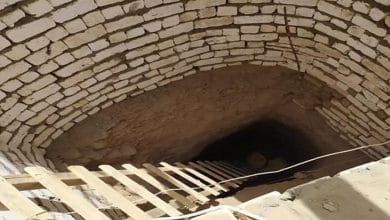
Introduction
In recent years, successive Egyptian governments have demolished many heritage sites, under the pretext of development, which infuriated citizens as well as specialists who condemned this unacceptable behavior.
However, the Egyptian government pursued its plans and did not heed such objections, although some of them later turned into interpellations and requests for briefing in Parliament, as well as lawsuits before courts.
It should be noted that this report deals with the issue of the demolition of heritage sites, not demolition of antiquities, as there is a big difference between them:
Archaeological sites are those sites registered with the Ministry of Antiquities, or sites that meet the conditions for registering antiquities but there are obstacles that may have prevented their registration, especially since the process of registering antiquities in Egypt is a complex process. The responsibility for the preservation of archaeological sites are stated in the Antiquities Protection Law No. 117 of 1983 and its amendments.
As for the heritage sites, they are those distinctive features that do not meet the requirements of archaeological site; but meanwhile, they have at least one of three or more these characteristics: having a distinct and unique architectural style, dating back to a specific historic period, or being a previous private residence for one of prominent historic figures. Preservation of heritage monuments is stated in Law No. 144 of 2006 and Law 119 of 2008.
The number of heritage buildings in Egypt, according to the official statistics, announced by the “Civilization Coordination Organization”, is about 6,500 buildings in many Egyptian governorates, such as: Cairo, Alexandria, Ismailia, Port Said, Minya, Assiut and others[1].
This report is divided into two axes, as follows:
First: Egyptian government and a long history in demolition of heritage
The demolition of heritage monuments in Egypt dates back to a long period of time, but reality has proven that its pace has terribly increased in recent years. The most recent of these demolitions is the decision to demolish parts of the Mameluke Cemetery, which was preceded by the demolition of the Elanbarien Agency, as well as other heritage sites and buildings.
This report will attempt to shed light on demolition of some heritage sites and buildings, including:
(1) Demolition of the Mameluke Cemetery
This cemetery is located in the Mameluke desert, currently located to the east of Salah Salem Road, where it was built during the era of the Circassian Mamelukes at the end of the eighth century AH. By the end of the ninth century AH, there was a group of religious buildings and domes that did not appear in one place like they did there. Sultan Qaytbay was the most Circassian Mameluke Sultan that was interested in the cemetery building; therefore it is also known in some sources as the “Qaitbay Graves”[2]
A few weeks ago, there had been great discontent on the part of the Egyptian people and some specialists following the spread of pictures and video clips of demolition of some graves in the Mameluke desert. This controversy reached its climax on social media, where users expressed their dissatisfaction with the demolition of the oldest cemeteries in the world.
The most prominent demolitions in the Mameluke Cemetery included:
1- The demolition of a large part of the tomb of Mohamed Mostafa Nadim, former director of the Egyptian House of Books, without whom the heritage of Poet Laureate Ahmed Shawki would have been lost, as Nadim, who died in 1930, was the first to print the collections of Shawki.
2- The walls of the tomb of Hassan Sabri Pasha, the prime minister of Egypt at the time of World War II, who refused to implicate Egypt in the war and spared the Egyptian nation its woes. Sabri died while delivering the throne speech before the House of Representatives in 1940 in the presence of King Farouk.
3- The façade of the tomb of Ahmed Lotfi Al-Sayed Pasha, the Egyptian philosopher and thinker and one of the founders of the National Party with Mustafa Kamel Pasha, known historically as the Master of Generations. Lotfi Al-Sayed, who served as rector of the Egyptian University and founded a number of linguistic academies and scientific societies, died in 1963.
4- The walls of the tomb of Ahmed Abboud Pasha, one of the pillars of the Egyptian economy in the twentieth century and one of the founders of Banque Misr, and the first Egyptian member in the board of directors of the International Suez Canal Company, died in 1963.
5- The grave of the late writer Mohamed al-Tabei, who was nicknamed “The Prince of Press” and died in 1976. “His articles were shaking governments and toppling ministries, and he was not afraid and did not back down…,” Late journalist Mostafa Amin, was one of al-Tabei students said.[3]
6- The tomb of Murad Mohsen Pasha, the principal overseer of the royal estate during the reign of King Farouk. It is noteworthy that the famous Murad Street in Giza was named after Murad Mohsen Pasha.
7- The outer wall of the tomb of Nazli Halim, granddaughter of Muhammad Ali Pasha the Great.
8- The walls of the tombs of Zaki Mohamed Al-Mohandis, who was previously the head of Dar Al-Uloum College. Zaki Al-Mohandis also was the father of the artist Fouad Al-Mohandis and the radio station broadcaster Safia Al-Muhandis.[4]
(2) Demolition of Elanbarien Agency
Elanbarien Agency, or Elanbarien Market, was the market that al-Maqrizi commented on, saying: “The perpetrators of crimes were imprisoned in that area … and the place remained a prison during the Fatimid and the Ayyubid eras until King Al-Nasir bin Qalawun rebuilt it to become Amber Bazar in 680 AH, known as Elanber Qaysariyya”[5]. Commenting on Elanbarien Agency and the Muizz Street, Ali Mubarak said: “This street is one of the greatest and most joyful streets in Cairo …”[6]
Elanbarien Market is located in the heart of the Muizz Street, old Cairo, one of the most important historic streets in Cairo, with an area of 1250 meters, containing 106 shops. The market witnessed many historic eras, like the Fatimid, Ayyubid, Mameluke and Ottoman eras, as it dates back to 517 AH (about 900 years), as a market for perfumes and amber. In the era of Muhammad Ali Pasha, it became a wonderful agency, which was a Wakf (endowment) for Ya’qoub Sabri Bey, one of Muhammad Ali Pasha’s assistants, who was the last to renovate and add to the place. Before Ya’qoub Bey died, he waived a quarter of the place to his wife and three quarters as a charitable endowment. In the 1950s, part of the agency was sold, to be owned by the heirs of Ya’qoub Bey’s wife and the new buyers and their heirs.[7]
Therefore, the Elanbarien Agency is greater than any ordinary heritage landmark. Although it was not registered in antiquities, yet it is an archaeological building that should have been added to the archaeological sites. However, the Ministry of Antiquities had a different view, confirming that Elanbarien Agency is not an archaeological site, which ultimately led to its demolition.[8]
(3) Other heritage buildings that were demolished
Although the demolition of heritage in Egypt was carried out at the hands of various governments, its pace has increased in recent years, as many historic villas and palaces as well as heritage buildings have been demolished, whether historic, belonging to prominent historic figures, or of a unique architectural and urban characteristics[9], especially in the governorates of Cairo and Alexandria, most notably the following:
1- In 2002, the street parallel to the Sufi Cemetery, where the famous polymath Ibn Khaldun was buried, (in Bab al-Nasr, Cairo) was expanded; and part of the cemetery was cut down in favor of the road expansion. Some reports indicate that the tomb of Ibn Khaldun, the first founder of sociology, may have been located in the part of the cemetery that was cut down.[10]
2- In 2014, the Al-Naqib Villa in Alexandria was demolished, although it was registered within the buildings of a distinctive architectural character. The villa was owned by Ahmed al-Naqib Pasha, who was the private physician of King Farouk and the royal family.[11]
3- In December 2014. The historic “Al-Mohandes House” was demolished on the Souk Al-Selah Street, which was full of dozens of ancient buildings in Al-Darb Al-Ahmar. The Al-Mohandes House is a building that is more than 150 years old, where some parts of it were built during the Mameluke era, as an integral part of the heritage of Old Cairo.[12]
4- In 2015, House No. 68 in Central Cairo was also demolished, despite the fact that it contained many Islamic funerary buildings. It contained three shrines of Sheikhs: “Al-Khribi, Al-Khawas and Al-Maghrabi”, and was affiliated with the Ministry of Endowments.[13]
5- In January 2016, the Villa Aghion in Alexandria, which is about 100 years old, was demolished, as its owner was able to completely demolish it, in total disregard of Egyptian laws, and despite issuance of a decision by the Council of Ministers to expropriate it for the public benefit to preserve it. The villa which was 1,800 square meters, was designed and built by French architect Auguste Perret in 1922.[14]
6- Also in 2016, the villa of “Zainab Al-Wakeel”, the spouse of Mostafa Al-Nahhas Pasha, in Alexandria, was demolished despite inclusion in the heritage folder of properties whose demolition is prohibited.[15]
7- In 2016, the Chicorel Villa, in Alexandria, was demolished. The villa was established by the Jewish businessman Chicorel in 1930, and it was not registered as antiquity. Most of Chicorel’s properties were confiscated following Nasser’s nationalization decisions in the 1950s and 1960s, where the ownership of the villa was transferred to the Arab Shipping Company.[16]
8- In January 2017, a heritage property dating back to the year 1891 (property No. 32) on the main street in the Sabbatiya district, Cairo, was demolished, with no response from the government.[17]
9- In January 2018, a partial demolition of the Continental Hotel, one of the Khedivial buildings in central Cairo, which witnessed the influx of European kings and queens during the opening of the Suez Canal in 1866, as well as many prominent historic and national events.[18]
10- Also in 2018, the Umm Kulthum Villa, in Cairo, which was built in 1938, was demolished, where an apartment building was built in its place.[19]
11- In November 2018, the government demolished the “Madkour Pasha” house, in al-Darb al-Ahmar, Cairo, which is a 600-year-old heritage building, and the demolition process took place even though it was registered in the list of the distinguished architectural style since 2010.[20]
12- Many other heritage monuments were demolished by the government, or by citizens after the government turned a blind eye to them. The governorate of Alexandria, for example, has been subjected to the demolition of many buildings and establishments of irreplaceable heritage value. Indeed, the government has officially permitted the removal of more than 50 archaeological buildings and villas in Alexandria from the heritage folder, thus giving the owners of these properties freedom to dispose of it, whether by demolition or sale.
In addition, there are more than 1,350 heritage buildings in Alexandria that are threatened with demolition.[21]
Second: Dangers of destroying Egyptian heritage and the need to stop it
What the government has been doing in recent years, or what it permits in terms of demolishing heritage buildings and monuments is a very dangerous behavior, which requires immediate act to stop these demolitions.
(1) Dangers of demolishing heritage sites
The demolition of heritage sites in Egypt is dangerous for the following reasons:
1- The demolition of heritage is demolition of the Egyptian memory, where future generations are deprived of getting acquainted with their history and heritage, and linking their present to the past of their ancestors.
2- The government’s demolition of heritage sites helps spread the culture of demolishing heritage buildings among citizens.
3- The demolition of heritage sites deprives Egyptian people of the right to enjoy the beauty of these architectural wonders.
4- The demolition of historic heritage implies loss of potential financial resources in Egypt, in case those buildings were converted into tourist attractions.
5- The cutting off, removal and demolition of any heritage building harms the distinct urban fabric of the area where it is located, taking into account that heritage links the past with the present.
6- The government’s removal of heritage is against the Constitution, as Article 47 of the 2014 Constitution explicitly states that the state is committed to preserving the Egyptian cultural identity with its various civilizational tributaries: “The State shall maintain the Egyptian cultural identity with its diversified branches of civilization.” – while Article 50 of the Constitution stipulates that: “Egypt’s civilization and cultural heritage, whether physical or moral, including all diversities and principal milestones – namely Ancient Egyptian, Coptic, and Islamic – is a national and human wealth. The State shall preserve and maintain this heritage as well as the contemporary cultural wealth, whether architectural, literary or artistic, with all diversities. Aggression against any of the foregoing is a crime punished by Law. The State shall pay special attention to protecting components of cultural pluralism in Egypt.”[22]
7- Also, the government’s demolition of heritage sites does not abide by the laws related to heritage preservation, such as Law No. 144 of 2006 about conserving architectural heritage. This law was concerned of protecting the buildings of distinctive value and buildings of high heritage value, stating that “Buildings and structures of distinctive architectural order or related to national history or a historic personality or those representing a historic era or considered a touristic destination; those are protected against demolition or modification.” Law 119 of 2008, which is also called the Urban Harmony law, and its executive regulations are responsible for conserving areas of distinctive value for their architectural and urban characters as well as buildings and other natural elements. This law stipulates that “The areas characterized by richness of contents of heritage, architectural, physical symbolic, aesthetic or natural value; and need to be dealt with as an integrated unit for conservation.”
8- The demolition of heritage also indicates that Egypt is not bound by the international conventions and treaties that it has already signed, such as the 1954 Hague Convention for the Protection of Cultural Property in the Event of Armed Conflict, which states that “damage to cultural property belonging to any people whatsoever means damage to the cultural heritage of all mankind, since each people makes its contribution to the culture of the world.”
Also the UNESCO Convention on the Means of Prohibiting and Preventing the Illicit Import, Export and Transfer of Ownership of Cultural Property, states that “it is incumbent upon every State to protect the cultural property existing within its territory against the dangers of theft, clandestine excavation, and illicit export.” Likewise, the 2001 UNESCO Universal Declaration on Cultural Diversity defines cultural diversity as “common heritage of humanity”, stating that: “The defense of cultural diversity is an ethical imperative, inseparable from respect for human dignity…” Also, the 2003 UNESCO Declaration concerning the Intentional Destruction of Cultural Heritage “recognizes the importance of the protection of cultural heritage and reaffirms its commitment to fight against its intentional destruction in any form so that such cultural heritage may be transmitted to the succeeding generations.”
9- One of the dangers that Egypt is exposed to as a result of heritage demolitions is deterioration of its reputation before international organizations, especially that the Egyptian government has precedents in this direction. In 2012, the United Nations Educational, Scientific and Cultural Organization (UNESCO) sent an official letter to Egypt’s Ministry of Foreign Affairs warning that the organization would remove the historic areas in Cairo and Luxor from the list of World Heritage areas, due to the increasing encroachments on archaeological and heritage monuments there.[23] In 2017, the UNESCO World Heritage Committee urged Egypt to take all necessary measures to end the rapid deterioration observed in Historic Cairo[24], in addition to the fact that several Egyptian monuments registered on the World Heritage List have been demolished since 1979.[25]
10- One of the most serious dangers facing Egyptian heritage is the officials’ significant underestimation of the nation’s heritage. The Ministry of Antiquities denies and even justifies many of the demolitions of heritage, under the pretext that the demolished buildings or sites are not registered among antiquities.[26] One of the ministry officials once said that if there is some negligence in some sites, there is interest in others![27]
(2) The need to stop demolition of heritage
These dangers require the need to immediately stop the demolition of heritage; and the Egyptian government must take necessary measures to preserve heritage, considering the following recommendations:
1- The need to feel proud of the Egyptian heritage that distinguishes the nation from other countries.
2- The need to pay attention to spreading cultural and heritage awareness among citizens.
3- The government must acquire and take care of all buildings falling within the scope of heritage, with offering compensation for owners of these properties.
4- The government must abide by the laws it has issued and the international treaties it has signed regarding heritage preservation.
5- The Parliament should play its role in legislation for enacting laws to raise the penalty for harming heritage in order to deter anyone who intends to do so, whether the government or the citizen.
6- The need to amend Law No. 144 of 2006 regulating the demolition of buildings and structures that are not prone to falls and preserving the architectural heritage, in order to prevent fraud for demolishing heritage and historic monuments.[28]
7- The need to empower the National Organization for Urban Coordination, which was established by Presidential Decree No. 37 of 2001 to take care of heritage, grant it more powers to enable it to supervise, protect, restore and develop heritage buildings.
8- The government must confront the demolition of historic buildings by some citizens, especially that there are committees in the governorates for heritage protection that reject these demolitions and considers them a major crime against Egypt’s cultural heritage.
9- Instead of demolishing heritage tombs in Cairo, a project should have been established to identify the burial places of influential figures in the modern history of Egypt, similar to the project of “Here lived…”, which identifies the residence of influential figures by placing a sign on their places of residence – as some specialists say, adding that the government should have diverted the path of the Paradise Avenue passing over the Mameluke Cemetery through a tunnel under the tombs.
10- The need to keep pace with global developments, for modern coexistence with heritage without resorting to its demolition, as has happened, for example, in Paris, where traffic flows through tunnels that you can hardly see.
11- It is also important for citizens to play their role in protecting heritage. They can found associations to protect heritage, and urge parliamentarians to play their role in monitoring and legislation in this regard. Citizens can also file lawsuits against anyone who may attempt to destroy heritage, relying on laws which stipulate that heritage buildings and sites should be preserved.[29]
Footnotes
[1] Al-Ahram, After the Elanbarien Agency crisis: demolition of heritage and historic buildings raises controversy, February 15, 2019
[2] Ayman Fouad Al-Sayed, Urban Development of Cairo since its inception until now, Cairo: Egyptian-Lebanese House, 1997, i. 1, p.57
[3] Al-Shorouk, 122 years have passed since the birth of the “Prince of the Egyptian Press” .. The “Parliament” prevented him from signing his articles, May 18, 2018
[4] Arabic Post, The government bulldozer runs over the “Mamelukes Cemetery” that contains the remains of Mamelukes, the granddaughter of Muhammad Ali Pasha, and the most important Egyptian writers and philosophers, July 24, 2020
[5] Ahmed bin Ali Al-Maqrizi, Al-Maqrizi Plans – Part 3, Dar Al-Kutub Al-Ilmiyya, Beirut, Lebanon 1418 AH
[6] Ali Mubarak, The New Tawfiq Plans: For Egypt, Cairo, and its Old and Famous Cities and Villages, The Great Amiri Press, Cairo, Downloads of Nour Library, 2006
[7] Hussein Doqeil, The government demolished the ancient Elanbarien Agency!, Al-Jazeera website, February 19, 2019
[8] Al-Ahram, After the Elanbrien Agency crisis, demolition of heritage and historic buildings raises controversy, February 15, 2019
[9] Noon Post, Here is Cairo – How can an ancient city lose its heritage?, February 14, 2019
[10] Sada El-Balad, where does the remains of Ibn Khaldun lie… The story of the lost grave among the graves of Sufis, October 7, 2018
[11] Abou Alhool Newspaper, Media and the Destruction of the Egyptian Heritage, article by Dr. Nasser Al-Kalawy, June 2014
[12] Al-Masry Al-Youm, Demolition of the “Elmohandes House” in Al-Darb Al-Ahmar, built during the era of Muhammad Ali Pasha, December 4, 2014
[13] Al-Bawaba News, A scandal … the demolition of 3 historic buildings in Cairo for the “antiquities mafia”, May 23, 2015
[14] Mobtada, The “Agion” Villa in Alexandria .. “With our own hands, we destroy history”, January 22, 2016
[15] Al-Ahram, Demolition of the ancient villa of Zeinab Al-Wakeel in Alexandria, January 18, 2016
[16] Masrawy, The demolition of the ” Chicoril Villa” – a new nail in the coffin of the Alexandrian heritage, October 2, 2016
[17] Noon Post, Here is Cairo – How can an ancient city lose its heritage?, February 14, 2019
[18] Asharq Al Awsat, Demolition of the historic Continental Hotel sparks controversy again about heritage buildings in Egypt, February 3, 2018
[19] Youm7, The “Umm Kulthum Villa” hit by the curse of demolition …, 4 January 2018
[20] Al-Watan, The shovels of demolition take down the ancient “Madkour Pasha House” in Al-Darb Al-Ahmar, November 24, 2018
[21] Youm7, After demolition of the “Lawrence Daryl Villa” in Alexandria, the crisis of demolishing archaeological villas worsens …, 23 September 2017
[22] The Egyptian 2014 Constitution, Article 50
[23] Hussein Duqail, World Heritage in Egypt: Between Addition and Deletion, Egyptian Institute for Studies, December 21, 2018
[24] Excavations, UNESCO raises the alarm: Can Egyptians save the heritage of Fatimid Cairo?, November 7, 2018
[25] Al-Quds Al-Arabi, Request for Briefing in Parliament and Signatures Campaign for Rejection of Demolition of “Historic Cairo Cemeteries”, July 22, 2020
[26] Masrawy, The first comment from the government on the demolition of the “Mamelukes Graves”, July 20, 2020
[27] Al-Ahram, After the Elanbarien Agency crisis: demolition of heritage and historic buildings raises controversy, February 15, 2019
[28] Al-Bawaba News, Exploitation of a legal loophole to demolish heritage … and demands to amend Law No. 114, February 19, 2018
[29] The views expressed in this article are entirely those of the author’s and do not necessarily reflect the views of EIPSS.




